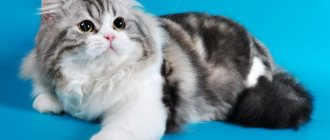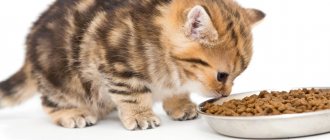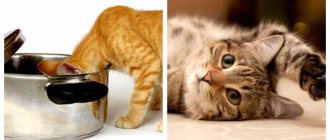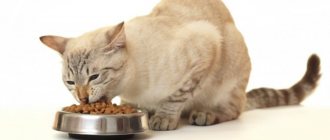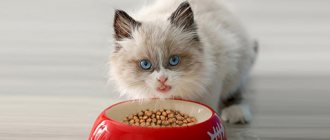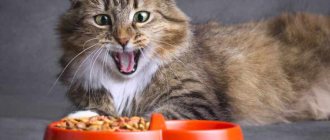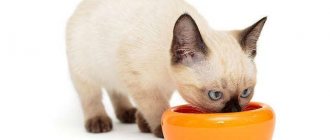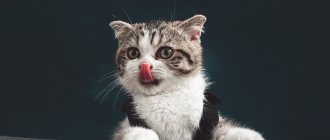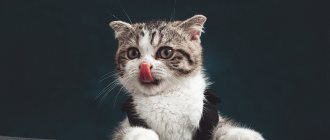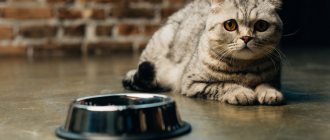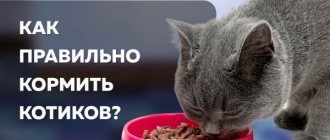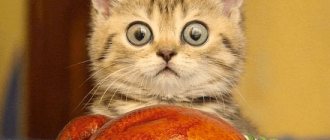It is no secret for cat owners that good, high-quality food is quite expensive. However, you need to feed the cat every day, and saving money on food can cost the animal its health, or even its life. Sometimes the owner makes the mistake of treating the cat to food from his table. It should be remembered that human food, richly flavored with seasonings, spices, sometimes fatty or too spicy, is not suitable for a cat. What to do in this case, only the owner of the animal must decide, but the choice is not so great: food prepared for the cat with his own hands or purchasing commercial food (dry or wet food). Probably, the first option is better and more reliable, because the owner knows what quality of products he bought and how he prepared them. But in terms of saving time, this option is not the best - a person who is busy most of the day is unlikely to be able to spend so much time cooking for a cat. If you are considering purchasing dry and wet food, you should first carefully study the composition of the product, read customer reviews, and ideally, consult a doctor.
Suitable food
It is important to choose the right food for your cat and cat. We'll tell you what to feed kittens, male cats, including spayed and neutered ones, as well as older pets.
Let's figure out what types of food there are for cats:
- Food “from the table”
- Natural food (“naturalka”)
- Dry food
- Canned food (wet food)
- Treats
Food from the table.
We discard it immediately if you want your pet to live a long and healthy life.
Many owners like to give food from the table, but the cat asks, probably hungry, he doesn’t have enough, but still eats with pleasure. Of course, he eats with pleasure, because the food from the table contains a lot of spices and flavor enhancers (by the way, salt is also a flavor enhancer; pay attention to how tasteless food without salt seems out of habit). In fact, human food from the table is strictly prohibited for cats. The presence of salt and spices negatively affects the health of the animal (urolithiasis is guaranteed) and, at best, this may result in a trip to the veterinarian, and at worst...
Of course, if one thing fell from the table and the clever glutton managed to eat it, nothing will happen to the cat, but do not turn this into a habit.
In addition to the negative consequences, if you train your cat to eat from the table, you will not be able to eat in peace without each bite being accompanied by a hungry look, and in some cases, an unscheduled concert.
Natural nutrition.
High-quality, balanced natural food for a cat is an excellent option; such food can be tailored specifically to the needs of a particular pet (by the way, this should be done by a veterinarian after examination and examination), taking into account its activity and living conditions. But in practice, with modern employment, few people can implement this efficiently.
There are several reasons:
- Few people are able to study a huge amount of information on nutrition in order to create a high-quality and correct diet. And there are also few owners who are ready to turn to specialists for this service, which, by the way, is quite expensive;
- proper natural nutrition implies that food for a cat will be prepared from high-quality and varied ingredients (fresh meat, offal, vegetables, vitamins and mineral supplements, of course), which is very expensive and difficult;
- even those who have passed the first and second stages “slow down” at the stage: make the cat eat this).
Most often, all this comes close to the first option: food “from the table”.
Dry food.
The most popular and most controversial option.
Ambiguous, because there are several classes of food: economy, premium, super-premium and holistic.
Economy class food is simply poison for your pet; animals cannot live long on such food. Premium is a little better.
If you want your pet to live long and be healthy, we recommend Holistic class food as the highest quality and most suitable food for your pet “predator”.
We wrote in detail about Holistic class food here and here .
Food is selected taking into account the characteristics of each individual pet, taking into account age (there are foods for all ages, in this case the feeding rate is regulated), activity, weight, allergies and possible contraindications.
If you feed only dry food, we recommend monitoring the level of water consumed - it should be three times more than dry food. Since most cats and cats drink little, this is the main disadvantage of feeding dry food. Dry food has low humidity, and, unlike natural and canned food, it adds virtually no moisture to the body. We wrote about how to encourage a cat to drink more and how water affects the pet’s body in the article Cats that drink little, what the dangers are and what to do about it...
Canned food (wet food).
You can feed only wet food, you can mix dry food and canned food.
If you mix wet and dry food, give your pet wet food separately from dry food so as not to mix different types of food. The main task of canned food in this case is to replenish the lack of water in the pet’s body.
Sometimes it happens that a special diet or food with a certain protein/fat ratio in the diet is required - then it is necessary to select food taking into account these characteristics.
When choosing a wet food, you need to consider how often and how much your pet eats canned food. If the amount of wet food exceeds 50% of the total diet, then choose only complete wet food to avoid vitamin and mineral deficiencies in your cat's diet.
If wet food is a treat, and the basis is dry food, then you can feed any high-quality canned food, both complete and supplementary. Read more about the types of wet food for cats in the article .
Feeding both dry and wet food has its advantages and disadvantages; for more details, see the article What food is best to feed a cat? Dry or wet: pros and cons.
Treats for cats.
You can also give special cat treats as a reward. But do not overuse the amount of treats, this is just a treat, not the main food, it does not replace the main diet and should make up no more than 10% of all calories consumed by the pet.
With a combined diet (dry food + treats + canned food), it is important to consider and comply with the total daily caloric intake. Many people don’t do this; they give them a daily allowance of dry food, additional canned food, and treat them with treats throughout the day. The result: a chubby pet and health problems from obesity.
If you want to know how to choose food, go to our detailed Checklist for choosing food .
Pets of different ages have their own dietary needs.
High-calorie Holistic class food is recommended for kittens. Some brands, such as Alleva, Farmina, Grandorf, Wellness Core, create separate foods for kittens. Their main feature is their higher calorie content. In brands that do not divide food by age, for example Acana, Orijen (not supplied to Russia), Boreal, Magnussons, GO!, it is important to choose the highest calorie food from the line, since the body grows in size and needs much more calories.
For adult cats, the diet must be selected taking into account their characteristics. For example, an active Maine Coon needs food with a high calorie content and large granules, while a lazy British or Scottish cat needs low-calorie food to avoid gaining excess weight.
For older cats, as well as castrated and sterilized cats, as a rule, special food is not needed and many brands do not include it in a separate line. However, often older cats, both spayed and neutered, begin to gain weight due to a decrease in activity level. In such cases, it is recommended to choose a lower-calorie food, which for marketing purposes is marked “for the elderly” (senior) or “for the spayed/neutered” (sterilized). If there is no excess weight with age or after castration, then you can feed them regular food for adult cats.
There is an opinion that it is important to feed sterilized cats and neutered cats only those marked sterilized. It seems that these foods provide additional prevention of urolithiasis. This is a myth that is actively exploited by large brands in their advertising campaigns. High-quality foods (all Holistic) have ingredients for the prevention of urolithiasis in all foods, and the high meat content in itself ensures such prevention. More details in the article .
If a cat has any diseases, then there are special diets, for example Farmina Vetlife, but the decision on transfer must be made by a veterinarian and in most cases the feeding period is strictly limited.
For more information about feeding older cats, see the article How to feed older and older cats? What to consider?
What to feed a cat: what natural products can be given to a cat
If you prefer to feed your cat natural products, there are several rules to consider.
What natural products can be given to a cat:
- To balance the diet, it is necessary to provide a high-quality vitamin and mineral complex.
- Preferred types of porridge in small quantities: rice and buckwheat. Or rice and buckwheat flakes.
- Of the by-products, the heart is the most preferable.
- Beef can be given raw or scalded with boiling water; it is better to boil other raw meat products.
- Raw chicken egg white contains avidin, which destroys B vitamins. Therefore, it is better to give the egg boiled or give the cat only the egg yolk.
Is it possible to give a cat fish, pork, milk, raw liver, bones, smoked meats?
Cats should not be given raw fish . River fish may contain pathogens of dangerous helminthic diseases. Raw sea fish contains the enzyme thiaminase, which destroys the vitamin thiamine, the lack of which can lead to nervous system disorders. In addition, fish contains excess phosphorus, which often leads to urolithiasis.
Boiled fish , especially mixed with rolled oatmeal, can also lead to urolithiasis. This mixture contains excess phosphorus due to fish, and rolled oats alkalizes the urine. Sharp small fish bones are very dangerous for cats. A little boiled fish won't hurt, but it shouldn't be your main meal.
Pork should not be given to cats due to its high fat content. In addition, pork and rabbit meat, especially in entrails that have not passed veterinary control, may contain pathogens of dangerous diseases.
Raw liver can cause stomach upset and even an excess of vitamin A. Pork liver is especially dangerous. Adult cats often experience stomach upset from whole cow's milk due to a deficiency of the enzyme lactase, which is involved in the digestion of the milk sugar lactose. It is better to accustom your cat to low-fat fermented milk products. If your pet cannot live without milk, then the milk must be diluted with boiled water and added egg yolk. Sometimes you can treat your pet with cheese or low-fat cottage cheese.
Bones should not be given to pets. They can cause gastrointestinal injuries.
What other foods should you not give to your cat?
- Chocolate, onions and garlic, and avocados are poisonous to cats.
- Do not give hot, spicy, salty, smoked or fried foods.
- Sour foods should not be given to pets.
- An excess of B vitamins and biotin darkens the color of cats with color point markings. These include cats of Siamese and Himalayan colors.
Psychological comfort
If an adult cat eats little or a lot and you are already tired of changing food, it may be worth thinking about the environment in which the pet eats. We have already said that one of the main problems may be a nervous environment when eating in the “cat canteen”.
How do you understand that there are problems and what can be done about it?
| The main thing that any pet should feel around its bowl is safety. If something frightens a cat, it will either try to eat in a hurry (which is not very healthy), or will begin to refuse food altogether. |
Here are signs that something is bothering your cat:
- wary, fearful behavior, the animal flinches at every rustle;
- constant attempts to look around;
- ears erect or “in airplane position” (set apart horizontally);
- the cat is hunched over or curled up into a ball.
So what makes a cat nervous? Perhaps it's other family members. Let's say the bowl is in the hallway and passing family members disturb the dining pet. Or an overly playful or loving preschool child terrorizes a pet without realizing it.
Then try moving the bowl under the table or to another hard-to-reach place. Sometimes the problem can be solved by turning the eating area so that the cat sits with its back to a wall or other safe area for it. Some “vertical” cats who like to climb and jump are happy to have their food bowl moved onto a nightstand or low shelf.
Convenient food bowl
Next, you need to make sure that the bowl is comfortable for your pet. A classic mistake is to feed your cat from a “human” plate or salad bowl. You also need to be careful with bowls that are too deep and narrow: your pet’s muzzle will, of course, fit in there, but its whiskers will touch the edges. Some cats are so unnerved by this that they completely refuse to eat.
| If there are several pets living in the house, then each should have their own bowls of food and water. Surprisingly, eating problems are more common in households with two or more cats than in households with a cat and a dog. However, we will devote a separate article to the topic of “multi-cat” houses. |
Diet
Many people are touched when they see fat cats on the street, on the Internet, on TV. All sorts of funny jokes happen to them, they look like thick balls of wool, and can barely move. But in fact, despite their cuteness, cats don’t want to be like that. They want to be healthy, not obese.
These tiny animals are susceptible to many human diseases: obesity, hypertension, clogged blood vessels and much more. If you don’t create the right diet, your pet will be in great danger, because often the desire to feed the animal to its fullest with all sorts of goodies will not bring any benefit. Because in this case the animal consumes much more energy than it expends.
With age, food portions need to be increased. For example, if you gave a tiny kitten 100 grams of food, when he grows up, you need to increase the portion to 400 grams. And, of course, the pet should have the opportunity to drink clean water at any time. When calculating the nutritional norm, you must also take into account the physical capabilities of the pet, its health and energy expended. How often to feed your cat can be found below.
Appropriate place
Finally, we note that it is completely unacceptable to place a bowl of food near the tray or in the bathroom. Some owners do this with what they think are the best intentions: after all, scattered food is much easier to remove from the tiles. We can only answer one thing: if perfect order in the house is so important to you, be prepared to clean up after your pet.
Feeding a cat next to the litter box is guaranteed to “break” its feeding behavior: these animals do not naturally make a toilet in the place where they eat.
___________
© All rights reserved. Partial or complete use of materials is permitted only if there is a link and/or a direct hyperlink open to search engines to the direct address of the material on the website Holistic-shop.ru.
